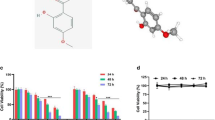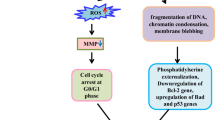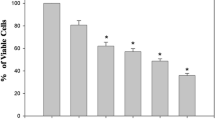Abstract
Cervical cancer is fourth most common fatal cancer in women worldwide. Lupeol is a dietary triterpenoid and has shown its anticancer efficacy against various cancer types with selectivity in targeting cancer cells. In the present study, anticancer efficacy and mechanism of action of a phytochemical, lupeol, in human cervical carcinoma (HeLa) cells has been examined. The anticancer efficacy of lupeol was assessed by trypan blue cell counting, annexin V assay, cell cycle analysis, expression of apoptotic proteins by RT-PCR and Western blotting and assessment of mitochondrial ROS generation by mitosox and mitotracker assays. Our results demonstrated that lupeol decreased cell proliferation and viability of HeLa cells significantly (p<0.001). Lupeol induced S-phase cell cycle arrest and also decreased the expression of S-phase Cyclins and CDKs and increased the expression of cyclin-dependent kinase inhibitors, p21 at transcriptional and translational level. Further, lupeol induced apoptosis and increased the expression of apoptosis markers such as cleaved PARP and Bax:Bcl-2 ratio. Furthermore, mitosox and mitotracker dye incubation followed by FACS analysis showed an increase in mitochondrial superoxide generation and reduction in healthy mitochondrial mass. These results suggest that lupeol could be an effective chemotherapeutic agent against cervical carcinoma due to its growth inhibitory activity through induction of S-phase cell cycle arrest and apoptosis.








Similar content being viewed by others
Abbreviations
- CDKI:
-
cyclin-dependent kinase inhibitor
- NAC:
-
N-acetyl cysteine
- PARP:
-
poly(ADP-ribose) polymerase
- ROS:
-
reactive oxygen species
References
Cai J and Jones DP 1998 Superoxide in apoptosis mitochondrial generation triggered by cytochromec loss. J. Biol. Chem. 273 11401–11404
Cottet‐Rousselle C, Ronot X, Leverve X. and Mayol JF 2011 Cytometric assessment of mitochondria using fluorescent probes. Cytometry Part A. 79 405–425
Green D R and Reed JC 1998 Mitochondria and apoptosis. Science 281 1309–1312
Hahm ER, Moura MB, Kelley EE, Van Houten B, Shiva S and Singh SV 2011 Withaferin A-induced apoptosis in human breast cancer cells is mediated by reactive oxygen species. PLoS ONE 6 e23354
Hanahan D and Weinberg RA 2011 Hallmarks of cancer: the next generation. Cell 144 646–674
He Y, Liu F, Zhang L, Wu Y, Hu B, Zhang Y, Li Y and Liu H 2011 Growth inhibition and apoptosis induced by lupeol, a dietary triterpene, in human hepatocellular carcinoma cells. Biol. Pharm. Bull. 34 517–522
Hinds PW 2003 Cdk2 dethroned as master of S phase entry. Cancer Cell 3 305–307
Janicek MF and Averette HE 2001 Cervical cancer: prevention, diagnosis, and therapeutics. CA: Cancer J. Clin. 51 92–114
Lee TK, Poon RT, Wo JY, Ma S, Guan XY, Myers JN, Altevogt P and Yuen AP 2007 Lupeol suppresses cisplatin-induced nuclear factor-κB activation in head and neck squamous cell carcinoma and inhibits local invasion and nodal metastasis in an orthotopic nude mouse model. Cancer Res. 67 8800–8809
Lee TKW, Castilho A, Cheung VCH, Tang KH, Ma S and Ng IOL 2011 Lupeol targets liver tumor‐initiating cells through phosphatase and tensin homolog modulation. Hepatology 53 160–170
Mukhopadhyay P, Rajesh M, Hasko G, Hawkins BJ, Madesh M and Pacher P 2007 Simultaneous detection of apoptosis and mitochondrial superoxide production in live cells by flow cytometry and confocal microscopy. Nature. Protocol. 2 2295–2301
Mullen P 2004 PARP cleavage as a means of assessing apoptosis. Methods Mol. Med. 88 171–181
Murtaza I, Saleem M, Adhami VM, Hafeez BB & Mukhtar H 2009. Suppression of cFLIP by lupeol, a dietary triterpene, is sufficient to overcome resistance to TRAIL-mediated apoptosis in chemoresistant human pancreatic cancer cells. Cancer Res. 69 1156–1165
Nambiar D, Prajapati V, Agarwal R and Singh RP 2013 In vitro and in vivo anticancer efficacy of silibinin against human pancreatic cancer BxPC-3 and PANC-1 cells. Cancer Lett. 334 109–117
Prasad S, Madan E, Nigam N, Roy P, George J and Shukla Y 2009 Induction of apoptosis by lupeol in human epidermoid carcinoma A431 cells through regulation of mitochondrial, Akt/PKB and NF-kappaB signaling pathways. Cancer Biol. Ther. 8 1632–1639
Pucci B, Kasten M and Giordano A 2000 Cell cycle and apoptosis. Neoplasia 2 291–299
Sabarwal A, Agarwal R and Singh RP 2017. Fisetin inhibits cellular proliferation and induces mitochondria‐dependent apoptosis in human gastric cancer cells. Mol. Carcinog. 56 499–514
Saleem M 2009 Lupeol, a novel anti-inflammatory and anti-cancer dietary triterpene. Cancer Lett. 285 109–115
Saleem M, Kweon MH, Yun JM, Adhami VM, Khan N, Syed DN and Mukhtar RH 2005 A novel dietary triterpene Lupeol induces fas-mediated apoptotic death of androgen-sensitive prostate cancer cells and inhibits tumor growth in a xenograft model. Cancer Res. 65 11203–11213
Saleem M, Maddodi N, Zaid MA, Khan N, Bin Hafeez B, Asim M, Suh Y, Yun JM, Setaluri V and Mukhtar H 2008 Lupeol inhibits growth of highly aggressive human metastatic melanoma cells in vitro and in vivo by inducing apoptosis. Clin. Cancer Res. 14 2119–2127
Scott EN, Gescher AJ, Steward WP and Brown K 2009 Development of dietary phytochemical chemopreventive agents: biomarkers and choice of dose for early clinical trials. Cancer Prev. Res. 2 525–530
Siegel R, Naishadham D and Jemal A 2013 Cancer statistics 2013 CA: CancerJ. Clinic. 63 11–30
Singh RP, Dhanalakshmi S and Agarwal R 2002 Phytochemicals as cell cycle modulators a less toxic approach in halting human cancers. Cell Cycle 1 155–160
Sun SY 2010 N-acetylcysteine, reactive oxygen species and beyond. Cancer Biol. Ther. 9 109–110
Surh YJ 2003 Cancer chemoprevention with dietary phytochemicals. Nat. Rev. Cancer 3 768–780
Susin SA, Zamzami N and Kroemer G 1998 Mitochondria as regulators of apoptosis: doubt no more. Biochim. Biophys. Acta 1366 151–165
Tal MC, Sasai M, Lee HK, Yordy B, Shadel GS and Iwasaki A 2009 Absence of autophagy results in reactive oxygen species-dependent amplification of RLR signaling. Proc. Natl. Acad. Sci. USA 106 2770–2775
Toshiya K, Testuya T, Akira H and Takuji T 2012 Cancer chemoprevention through the induction of apoptosis by natural compounds J. Biophys. Chem. 3 157–173
Walboomers JM, Jacobs MV, Manos MM, Bosch FX, Kummer JA, Shah KV, Snijders PJ, Peto J, Meijer RCJ and Munoz N 1999 Human papillomavirus is a necessary cause of invasive cervical cancer worldwide. J. Pathol. 189 12–19
Yim EK and Park JS 2005 The role of HPV E6 and E7 oncoproteins in HPV-associated cervical carcinogenesis. Cancer Res. Treat. 37 319–324
Acknowledgements
NP is recipient of UGC Non-NET Fellowship from Central University of Gujarat, Gandhinagar, UCSY is recipient of Ramanujan Fellowship from Department of Science and Technology (DST)/Science Engineering and Research Board (SERB), India.
Author information
Authors and Affiliations
Corresponding author
Additional information
Corresponding editor: Sorab Dalal
Rights and permissions
About this article
Cite this article
Prasad, N., Sabarwal, A., Yadav, U.C.S. et al. Lupeol induces S-phase arrest and mitochondria-mediated apoptosis in cervical cancer cells. J Biosci 43, 249–261 (2018). https://doi.org/10.1007/s12038-018-9743-8
Received:
Accepted:
Published:
Issue Date:
DOI: https://doi.org/10.1007/s12038-018-9743-8




